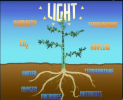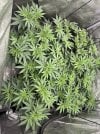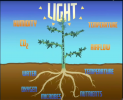"that"—I counted up six assertions that I made in the text that you quoted. It would be more productive if you were more specific.
Ah, OK. I'll take the comment "squeeze out every bit". Got it.
From what you've written here, it sounds like you fed your plants a lot of light for one or more grows and didn't like the results from that approach as well as you did when you gave your plants less light.
If you're happy with the results when you just "let them casually do their thing", then that's a good approach for you. And that's what counts, as I see it. There are a huge number of different ways that growers run their plants and if you're getting the results that you want, run with it.
It's not clear what "super diligent with feedings and climate" would entail but I will argue that, by reading the plant, a grower can get his plants to their light saturation point. In some grows, that will be 1000µmol but for other grows it might be 800µmol.
As you argue below, that's where observing the plant is important. And that's why I try to remember to advise growers how to increase their light levels the right way—bump the PPFD early in the day, check the plants 30 minutes later, then check them again 30 minutes later. If a grower follows that approach, things should turn out really well.
Another way to look at it is that if a grow can't tolerate light at the 800-1000 level or at the manufacturer's recommended settings (except for AC Infinity's numbers), then it might be a good idea to find out why. The reason I say that is that it's a simple fact that cannabis will thrive in 800-1000µmol in a "reasonably good" environment, meaning the environmental conditions that every cannabis seed seller and grower forum recommendation. You might not agree with that but that doesn't change that fact.
With that in mind, if a grower is in a situation where their plants are having trouble with that level of light, that's an indicator that they don't have a "reasonably good" environment. I have seen two grows where the plants could not handle >500µmol of light. It took some sleuthing but it eventually came down to poor watering practices that had caused the soil to be hygrophobic in some places.
You'll notice that I'm not arguing against your specific points because, well, it would be like nailing jelly to a tree. I tend to have a "can do" attitude rather than a "can't"attitude. You're asserting that you need to have certain conditions to try to disprove…well, you even really state your counter argument very well. My approach is more oriented toward "can do" as in - if you do "A, B, and C" then "X, Y, and Z" will tend to happen because, in this case, that's researchers are seeing in their labs and growers are seeing in their tents.
So, I'm not going to try to dispute your assertions about why something won't work. It's too much work and "the argument is never the argument". Instead, I'm passing along information about cannabis grow lighting and allowing the reader to make their decision about whether to use it or not.
If your grows haven't turned out as expected, perhaps there's something you overlooked. Don't know if that's the case but below is graphic that I found helpful.
View attachment 5470810
"trying to squeeze every last gram of yield out of a harvest" — Kelly's Heros "Always with the negative waves, Moriarty. Always with the negative waves."
Perhaps that's part of the issue. Understanding light levels in plants is one of the basics of growing cannabis but new growers don't learn about it. I think there are two reasons. One is marketing by fertilizer manufacturers. New growers, myself included, are mesmerized by the myriad bottles of nutrients. Those companies spend a lot of money on dazzling buyers and it works. They're able to take the same set of 18± chemicals and make their formulation "the best". The fact that it's fundamentally no different that the magic potions sold by any other vendor makes no difference. They're masters at marketing and growers are happy to open their wallets.
Another driver is the FUD from other growers and I see a lot of it coming from long term growers who are very comfortable with what I refer to as "legacy light levels", harking back to the HPS days when a grower could do real harm to a plant, something that falls into the category of gross negligence if that happens with today's cool running LED's.
I do see thing changing. In the same way that it took me three grows to move away from legacy light levels, I think the current generation of growers are more comfortable with the digital world and a lot of long terms growers are moving in that direction, as well.
So, yes, master the basics, I agree and one of the basics is how much light to give a plant. If a grower doesn't understand it, it's probably not because they can't, as I see it. My perspective, and I've seen this in other places, is that most people can understand issues if, one, they're interested in it, and, two, if it's explained by someone who understands it.
See my comment about "negative waves". Your first sentence is a backhanded implication that plants that are getting light levels where they thrive aren't "happy". And yet, when plants are praying, which I believe to be an indication that they are getting high levels of light, are categorically said to be "happy".
At the real world level, if a grower can't get 800-1000µmol on their grow by the time they hit flower, they might want to figure out why. If they can do so, they will get a larger crop of higher crop quality and, to a lesser extent, higher bud quality (more secondary metabolites) but if they can only grow at, say, 700 or if they want to grow at that level, that's completely up to them.
Yeh, I saw that. That's, one, a statement of the obvious and, two, pretty much useless because it doesn't mention the impact of turning down the light in terms of extending the service life light, saving electricity, and reducing yield.
At the commercial level, I'd have to question someone's understanding of business principles because the idea of buying a light that's larger than needed simply to turn it down so that it last longer is in a word "nonsense", the underlying assumption being that the company wants to show a profit.
If anyone's interested in how that works out for a home grower, run it through chatGPT and you'll see that if you cut down your input wattage by 25%, you'll extend the service life of the fixture from 6.2 years to 8 years (or some such). You're also saving on electricity. That's all well and good but it also means that you're reducing your yield by about 20% and, given the value of a cannabis crop, it becomes cost ineffective to follow that strategy because you're spending extra money in today's dollars and reducing yield throughout the life of a grow to extend the life of a grow light that will be technologically obsolete well before the end of its service life.
Some things are simple—don't eat yellow snow. Calculating the value of turning down the wattage of a light fixture in a cannabis grow to extend the life of the light is fairly involved. As my battery commander used to say, "If you don't realize that then you truly don't understand the problem."




